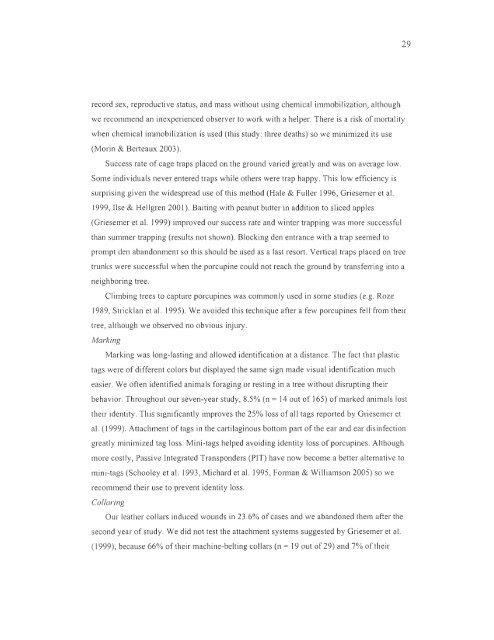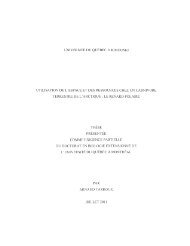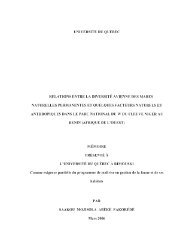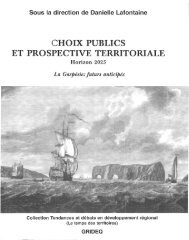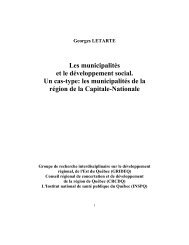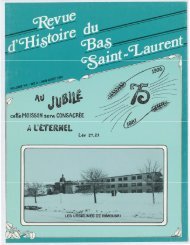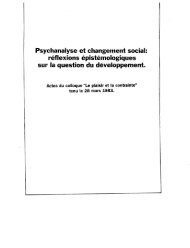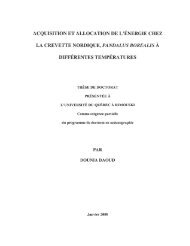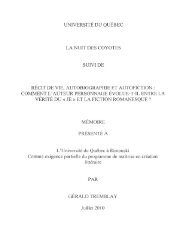influence du climat et de la prédation sur l'utilisation de l'habitat et la ...
influence du climat et de la prédation sur l'utilisation de l'habitat et la ...
influence du climat et de la prédation sur l'utilisation de l'habitat et la ...
You also want an ePaper? Increase the reach of your titles
YUMPU automatically turns print PDFs into web optimized ePapers that Google loves.
29<br />
record sex, repro<strong>du</strong>cti ve status, and mass without using chemical immobilizati on, although<br />
we recomm end an inexperienced observer to work with a helper. There is a ri sk of mortali ty<br />
when chemical immobilizati on is used (this study: three <strong>de</strong>aths) so we minimized its use<br />
(Morin & Belteaux 2003).<br />
Success rate of cage traps p<strong>la</strong>ced on the ground varied greatl y and was on average low.<br />
Some indivi<strong>du</strong>als never entered traps while others were trap happy . This low effi ciency is<br />
<strong>sur</strong>prising given the wi<strong>de</strong>spread use of this m<strong>et</strong>hod (Hale & Fuller 1996, Griesemer <strong>et</strong> al.<br />
1999, Ilse & Hell gren 2001 ). Baiting with pean ut butter in addition to sliced apples<br />
(Gri esemer <strong>et</strong> al. 1999) improved our success rate and winter trapping was more successful<br />
than summer trapping (results not shown). Blocking <strong>de</strong>n entrance with a trap seemed to<br />
prompt <strong>de</strong>n abandonment so this should be used as a <strong>la</strong>st resort. Velt ical traps p<strong>la</strong>ced on tree<br />
trunks were successful when the porcupine could not reach the ground by transferring into a<br />
ne ighboring tree.<br />
C limbing trees to capture porcupines was commonl y used in some studies (e.g. Roze<br />
1989, Strick<strong>la</strong>n <strong>et</strong> al. 1995). We avoi<strong>de</strong>d this technique after a few porcupines fe U from their<br />
tree, although we observed no obvious in jury.<br />
Marking<br />
Mal'king was long-<strong>la</strong>sting and allowed i<strong>de</strong>ntificati on at a distance. The fact that p<strong>la</strong>stic<br />
tags were of di fferent colors but disp<strong>la</strong>yed the same sign ma<strong>de</strong> visual i<strong>de</strong>ntificati on much<br />
easier. We often i<strong>de</strong>ntified animaIs foraging or resting in a tree without disrupting their<br />
behavior. Throughout our seven-year study, 8.5% (n = 14 out of 165) of marked animaIs lost<br />
their i<strong>de</strong>ntity. This significantly improves the 25% 10ss of ail tags reported by Griesemer <strong>et</strong><br />
al. (1999). Attachment of tags in the calti<strong>la</strong>ginous bottom palt of the ear and ear dis infection<br />
greatly minimized tag loss. M ini-tags helped avoiding i<strong>de</strong>ntity loss of porcupines. Although<br />
more costl y, Passive Integrated Transpon<strong>de</strong>rs (PIT) have now become a b<strong>et</strong>ter alternati ve to<br />
mini-tags (Schooley <strong>et</strong> al. 1993, Michard <strong>et</strong> al. 1995, Forman & Will iamson 2005) so we<br />
recommend their use to prevent i<strong>de</strong>ntity loss.<br />
Co /<strong>la</strong>ring<br />
O ur leather coll ars in<strong>du</strong>ced wounds in 23 .6% of cases and we abandoned them after the<br />
second year of study. We did not test the attachment systems suggested by G riesemer <strong>et</strong> al.<br />
(1999), because 66% of their machine-belting coll ars (n = 19 out of 29) and 7% of their


